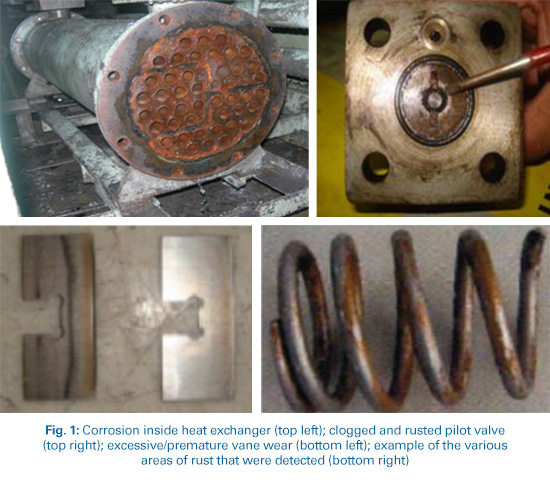Benefits of Converting from Water Glycol to Synthetic
Water-Free Fluids in Die Casting Hydraulic Fluid Systems
By Gilbert van Baren, Quaker Chemical Corp.
In fire-hazardous areas, such as die-casting plants where hydraulic equipment is in operation close to hot, liquid metal (zinc, aluminum, magnesium), it is strongly advised to use a fire-resistant hydraulic fluid. Standard mineral oil-based hydraulic fluids have a low fire resistance and can create a high danger when a leakage near a hot surface or liquid metal occurs.
HFC (Water Glycol)
In die-casting plants, the most commonly used fire-resistant hydraulic fluid is Water Glycol (HFC). This hydraulic fluid type is a mixture of approximately 40% water, 40% Glycol, 15% thickener, and 5% additives. Although HFC has good fire resistance and is cost competitive, it also has clear disadvantages from its composition.
Case Studies
The high water content in HFC fluids typically causes issues, like corrosion and poor lubrication in the pumps and valves on a regular basis. The following case studies detail the challenges two automotive parts manufacturers were facing in their die-casting operations, and the alternative fluid they converted to, which not only overcomes all the disadvantages of an HFC fire-resistant hydraulic fluid, but also brings additional advantages.
Case Study #1: Poor Lubrication, Unacceptable Pump Life
An automotive parts manufacturer was looking to replace the water glycol (HFC) fire-resistant hydraulic fluid being used to operate its die-casting equipment. The fluid being used had the typical lubricating properties of water glycol fluids, and the following were unacceptable attributes for this manufacturer:
• Poor pump lifetime
• Increased pump wear
To help improve operations, the manufacturer tested QUINTOLUBRIC® 888 polyol ester (HFD-U) fluids as a potential replacement. As expressed in Table 1, with the conversion to the HFD-U, lubrication improved, resulting in reduced wear and increased lifetime on the pumps and seals, as well as reductions on costs for replacement parts and lower energy consumption.

Case Study #2: Corrosion and Problems with Water Treatment (high COD)
Another automotive parts manufacturer was looking to replace the water glycol (HFC), fire-resistant hydraulic fluids used to operate its die-casting equipment. The fluid being used was causing severe corrosion issues in several parts of the machine (Fig. 1).

The manufacturer also had problems with the waste treatment of the fluid due to the fact that water HFC mixes easily with water. As a result, the HFC fluid cannot be skimmed off, and the manufacturer was experiencing high amounts of waste and waste treatment costs.
After introducing QUINTOLUBRIC® 888, corrosion issues were eliminated, which improved machine production by 5%. Since it is lighter than water, the fluid can be removed from the wastewater streams by skimming. This makes it easier to remove during waste treatment processes compared to the HFC fluid, which significantly reduces the amount of waste and waste treatment costs.
The environmentally friendly QUINTOLUBRIC® 888-46 can be introduced as a replacement for HFC to help improve operations in a die-casting plant with
• superior lubrication properties,
• reduced fluid maintenance (e.g., no water evaporation),
• reduced energy consumption up to 15% (by having a lower density), and
• increased production capacity by 5%.

Conversion is straightforward and can be done without any adaption to the current system, no changes to seals, pumps, or any other components. A key part of the conversion is to remove as much HFC fluid as possible in order to get the water content <2000 ppm (<0.2%).
For more information: Gilbert van Baren is product manager fluid power, for Quaker Chemical Corp. Visit www.quakerchem.com to learn more.